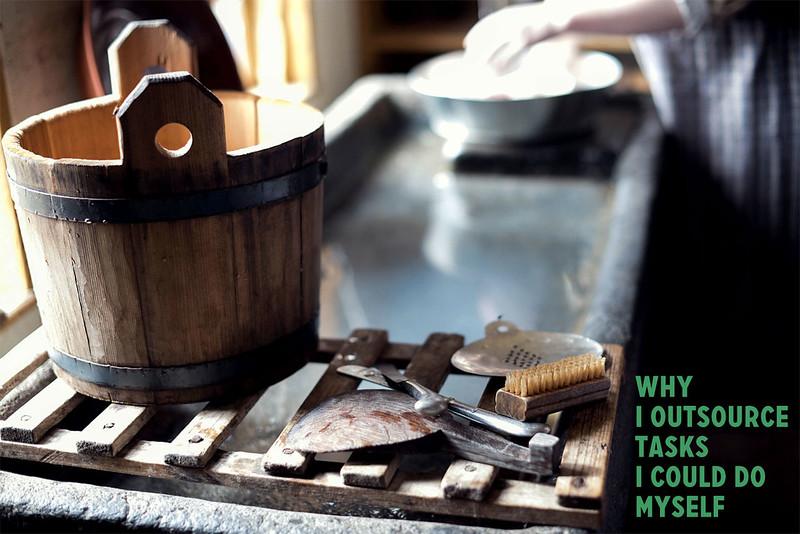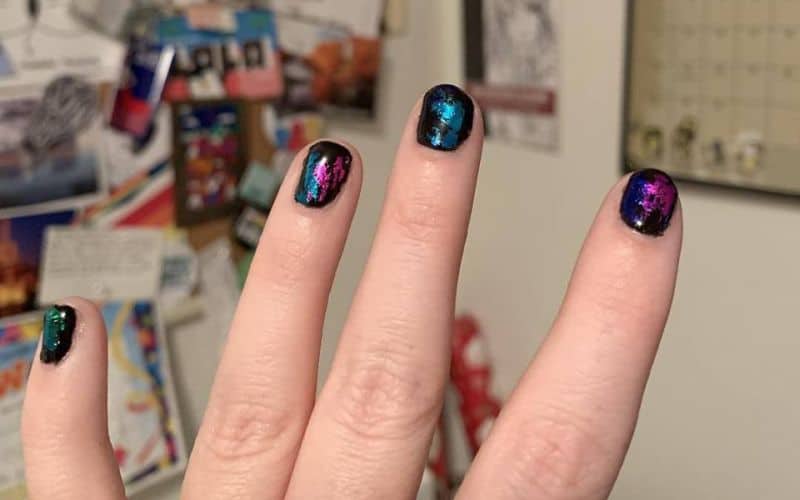I like to travel. Over the past decade, I've probably made an average of two international trips per year. But you know what? Never once in that time have I tried to track how much I spend while exploring the world. Sure, I log my numbers in Quicken (as I do for everything), but I've never analyzed the cost of an individual trip.
This month, I flew to Europe to hang out with my cousin Duane again. He and I enjoy traveling together. Because I was curious, I decided to be diligent about tracking my expenses for this trip.
Note, however, that I didn't try to do anything different. I didn't adjust my normal behavior simply because I knew I'd be reporting to GRS readers. I did what I always do. I spent in ways that felt normal to me.
I don't need a fancy hotel, for instance. Neither does Duane. We're happy with cheap, simple lodging. And because most of the time we don't book rooms in advance, we don't hunt for the best deal. When we decide to stop for the night, we look for a place to stay. When we find something reasonable ($50 per person per night is our target) and available, we book it. We don't continue to search. We'd rather use our time to explore our surroundings.
On the other hand, we're both willing to splurge on food from time to time. Our rooms aren't important to us, but what we eat is.
Similarly, we'll pay to see special sites, but mostly we're happy visiting free museums and/or walking around a city. We don't pay much for tours, etc.
So, how much did I spend for two weeks in Europe? Let's find out!

Chateau Chenonceau in France's Loire Valley
Booking Flights
This trip was sort of spontaneous. Remember, Duane has throat cancer. We expected our trip in December to be the last adventure we had together. But his health has held steady — and his doctor is making hopeful statements that he might be around for Christmas! — so we decided to make another trip.
Generally, I try to book flights several months in advance. I feel like I find cheaper options that way. This time, though, I didn't book my flight until April 19th, less than a month before our trip.
Also, I'm fussy about flights. It's not that I need to sit in business class — I'm perfectly happy in coach — but I don't like layovers. I'm willing to pay extra for a direct flight.
Unfortunately, when I searched for flights from Portland to Paris, I couldn't find any direct flights. I could, however, find a non-stop to London. I like London. It's a pleasant city. “What if,” I thought, “I flew to London a few days early and used that time to get some work done? Then I could take the Chunnel train across to Paris to meet Duane when he arrives.”
So, I booked a flight to London. It cost me $996.63 and each leg took roughly 10.5 hours.
(I don't know how much Duane paid for his plane ticket. I think it was around $600, but he had to fly from Portland to Las Vegas to Los Angeles to Paris and it took him almost 24 hours. Yuck. I'm happy to pay a premium to avoid crap like that.)
I made a small mistake when booking my ticket. In the past, I've always traveled economy. That's what I thought I was doing this time. Nope. Apparently, there's a new(-ish) airfare class called “basic economy”. This is a massive “screw you” from the airlines to their customers. It's a little bit cheaper, but you're not allowed to make any changes to your ticket once you've booked. No option to upgrade. Plus, you board dead last. And you can't choose your seat. And if you check a bag — as I did for my return flight — it costs a ton.
Edinburgh
I flew into London with no real plan for the first few days. Brandon (the Mad Fientist) had invited me to visit him and his wife in Edinburgh, Scotland, but I felt like I oughtn't do it. I felt like I should stay in London and work.
When I landed, though, I changed my mind. “Is it still okay if I come up to see you?” I asked. “Sure!” Brandon said. So, I hopped on Trainline (an awesome app that Duane and I used to buy train tickets during our December trip) and booked a ticket from London to Edinburgh. Cost: $101.92.
While waiting for my train at Kings Cross station (and watching the tourist throngs at Platform 9-1/2), I withdrew £200 for spending money, which is about $252.31. I used this cash to buy things like coffee and snacks and souvenirs. I brought home £141.15, which means I spent £58.85 (or about $74.24) cash while in the U.K.
I had a great time hanging out with Brandon and Jill. They showed me everyday life in Edinburgh, one of my favorite cities. They put me up in their spare room, took me to pubs, and we wandered together through the streets and the parks.
While there, I spent:
- $45.76 at Brewdog for beer and snacks. (Did you know that low-alcohol beer — like 0.5% to 2.0% — is a thing in the U.K.? I wish it was a thing here in the U.S. I'd buy it.)
- $17.74 at Whiski Bar for an hour of music and Scotch.
- $9.91 at Cairngorm Coffee, where Brandon and I spent a morning working.
- $33.78 at Mother India restaurant, where the three of us had a fine meal of “Indian tapas”.
In all, I spent a total of $283.35 during my three nights in Scotland.

Picnic in the Meadows with the Mad Fientist and friends
Paris
When it came time to meet Duane in Paris, I was faced with a choice. Originally, I had intended to take the train from London to Paris. But when I looked at times and prices to get from Edinburgh to Gare du Nord, I didn't like what I saw. The trip would take about 12.5 hours and the total cost would be over $350. Yikes!
“You should book a flight on EasyJet,” Brandon suggested. I've never used EasyJet, but I looked into it. For $199.45, I could fly from Edinburgh to Charles de Gaulle airport (CDG) in Paris — in less than two hours. I booked a ticket. Then, using Chase Ultimate Rewards points, I booked one night at the Hotel ibis, which is attached to CDG terminal 3. My cost: 7718 Chase points.
In Paris, I paid €17.99 for a one-day train pass, which gave me unlimited access to all Metro and RER routes. (The metro lines are the subway and local trains. The RER routes are the commuter trains that run deeper into the suburbs, going places like Versailles and the airport.) I also withdrew €200 in cash (about $222.50) to use for incidental expenses, such as snacks and souvenirs.
While I waited for Duane's flight to arrive, I visited Notre Dame to see what it looked like after the fire. (I was startled to note that when the wind was right, you could smell the ashes!) I bought an extra travel shirt. And I met my friend Amy for champagne and charcuterie. (Amy lives in Houston but happened to be in Paris for work.)
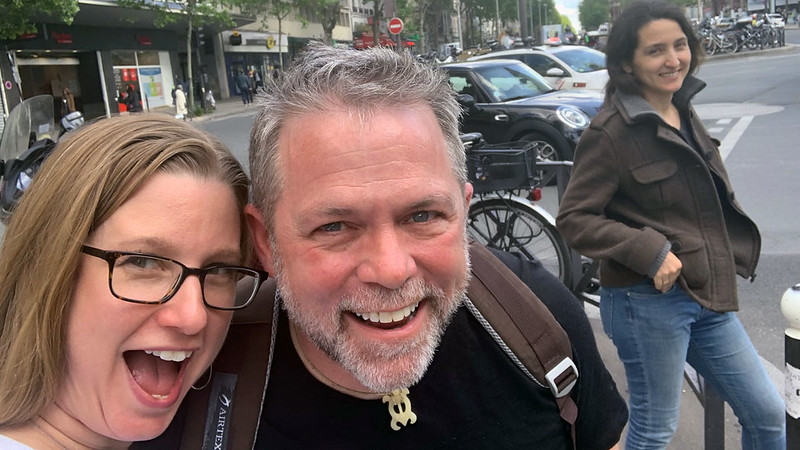
Amy, J.D., and random amused French woman
At around 18:00, I returned to the airport to pick up our rental car. I was worried this might not go smoothly, but I was wrong. Estelle, the young woman at the Avis counter, was amazing. It didn't take long for her to get met set up with a Peugot 208. Plus, she was kind enough to phone ahead to our hotel to let them know we'd be a little late. I booked the car with British Airways points. My cost: 16,600 Avios — a bargain!
As I was finishing at the rental car, Duane cleared immigration. Perfect timing! We hopped in our little car, braved Paris traffic and made our way to the garden spot of Giverny.
In Giverny, we checked into our B&B (booked with 8154 Chase points), then hurried to the only restaurant in town that was still open. Duane spent €51.00 on our dinner of duck breast and red wine.
During two nights in and around Paris, I spent $199.45, €17.99, 8154 Chase points, and 16,600 Avios (BA points). Duane spent €51.00.
Normandy
The next morning, Duane and I started our driving tour of northwest France. I'd been worried that all French drivers would be like the ones in Paris. They weren't. On the country roads, people were much more mellow. Thank goodness. (I drive like an old man. I hate speeding and tailgating.)
First, we toured Rouen, the town where Joan of Arc was burned at the stake. We saw our first cathedral of the trip, visited the (free) Museum of Fine Arts, and browsed the weekly market.
Duane and I both enjoy markets. We're happy to pass time looking at fruits and vegetables and meat and fish. For real. Plus, this gave us a chance to buy cheap food for the road. I picked up a paper sack filled with twenty baby chorizo sausages, for instance, and it cost only €5. (I think there were more than 20 sausages in the bag too. That thing lasted me almost the entire trip, and I was eating several sausages per day.)
In the afternoon, we drove to Honfleur with no plans about where to stay. The first hotel we visited was perfect: cheap and efficient. I paid €100.00 to book a room. Duane spent €54.00 on our dinner at a local pub.
On our second day, we meandered along the coast. We stopped to taste calvados (an apple brandy made in Normandy), nibbled goat cheese in Deauville, and stopped to visit the Grand Hotel in Cabourg, the site of Proust's famous memory-inducing madeleine.
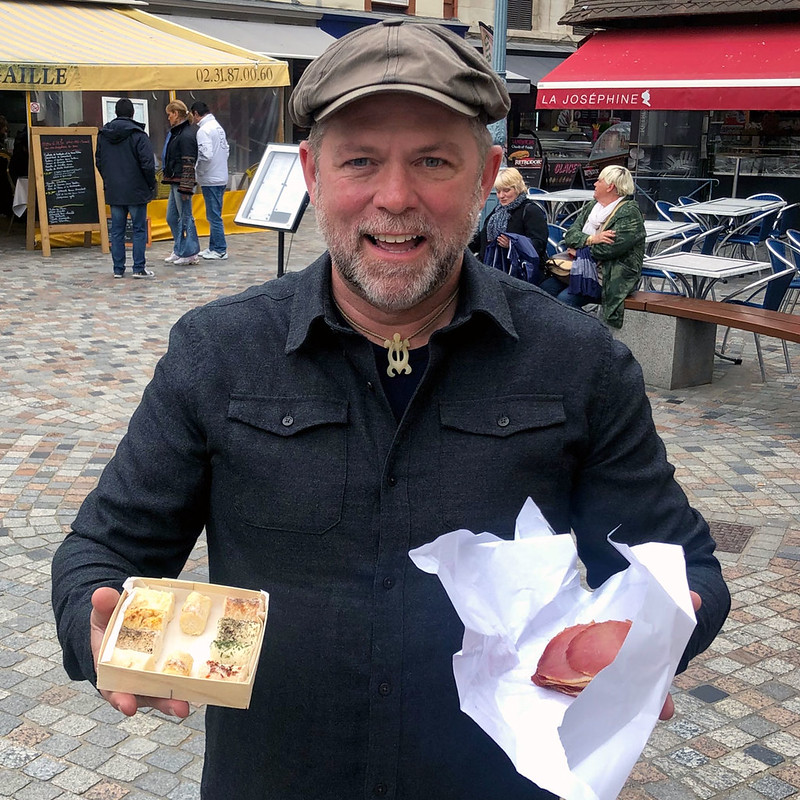
Buying goat cheese and “bacon” in Deauville
In the late afternoon, we reached Bayeux. Our first hotel choice was booked, but the second had two cheap rooms available. We paid €49.00 each. For dinner, we chose an expensive restaurant (I can't remember why) that cost Duane €94.00.
After dinner, we wandered around town. It was a magical evening in mid-spring. We happened to hit the city during its “festival of lights”, and when we stopped by the cathedral, an American choir was performing a concert. We stopped in to listen.
In the morning, we visited the Bayeux Tapestry, a 70-meter long work of art that's nearly 1000 years old. In dozens of scenes, it depicts the Norman conquest of England. People think I'm joking when I say this, but I'm not: This tapestry is like a very early comic book. (And, in fact, the drawings used to plan tapestries like this are referred to as cartoons. No joke.) This visit cost me €19.00.
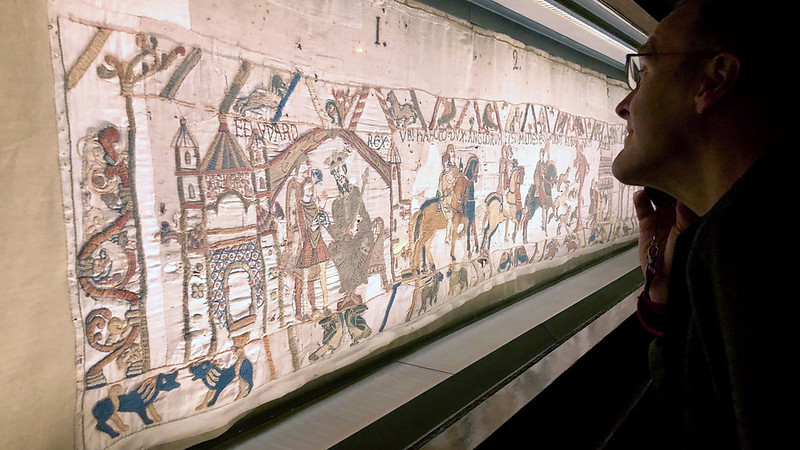
Seriously, the Bayeux Tapestry is like a primitive comic book
While in Bayeux, we visited Omaha Beach and the nearby American Military Cemetery. After that, we drove backroads to reach Mont-Saint-Michel, one of the most famous tourist sites in all of France (and formerly one of the top three destinations for Christian pilgrims). This island used to be isolated from the mainland by ocean tides. Now there's a causeway that leads to it, but even that sometimes floods over (as it did during our stay).
I used 14,538 Chase points to book a room on the island, and I'm glad we did. During the day, the place is packed. After 18:00, the crowd disperses and things become peaceful. It's fun to wander the ramparts with nobody to disturb you.
Here, Duane paid €89.00 for dinner.
During our time in Normandy, I spent a total of €168.00 and 14,538 Chase points. Duane spent €286.00.

Mont-Saint-Michel at high tide
Brittany
The next morning, after a quick tour of the Mont-Saint-Michel abbey, Duane and I packed up to drive to Brittany. (The island actually sits on the border between the two regions.)
As we entered Brittany, we got our first taste of fuel prices in France. To put 38 liters (about 10 gallons) in the Peugot 208, I paid €60.00. Holy cats! That's nearly $7 per gallon, or about twice what we pay here in the States.
In the early afternoon, we stopped for a couple of hours in the walled city of Dinan, which is built on a hillside overlooking the river Rance.

Looking from the ramparts of Dinan to the valley below
By early evening, we'd reached Carnac on the Atlantic coast. Carnac is famous for its “standing stones”, a collection of 3000+ domens and menhirs in the region. I love sites like this (and Avebury and Stonehenge in England), so was pleased to visit. (If you've ever read any Asterix comics, you're familiar with the stones of Carnac.)
The first hotel we visited had a cheap room available (€66.00), so we booked it. Our dinner next door was…an adventure.
Brittany, as you may know, is the source of the crepe. It's also the source of the galette (a savory crepe). Crepes and galettes everywhere in this region. Because we like to try local food when we travel, Duane and I decided to eat galettes for our evening meal. “You should get the andouille,” the restaurant owner told us, smiling. So we did.
Well. It turns out that American andouille is not the same as French andouille. French andouille is simply sliced pig intestine that has (ostensibly) been cleaned very, very well.
“This tastes like ass,” Duane said as he ate his galette. He couldn't finish. I did finish, but was a little mortified when I looked up the ingredients later. Our host seemed to take pity on us for being such good sports. When I ordered a glass of calvados after the meal, he gave me a huge pour.
I paid €46.00 for our dinner of pig-gut pancakes.
During our 24 hours in Brittany, I spent a total of €172.00. Duane spent nothing.
The Loire Valley
After a quick breakfast of coffee and crepes (€12.00 paid by Duane), we made our way to Angers, former capital of the Anjou region. (Angers is the source of both anjou pears and Cointreau liqueur.) Here, we visited our first chateau. Did you know that a chateau is a castle? I didn't — not until this trip.
Anyhow, the Chateau d'Angers is home to the amazing Apocalypse Tapestry, a 600-year-old visual retelling of the apocalypse story from the Bible's Book of Revelation. Like the Bayeux Tapestry, it reminds me of a massive comic book made from cloth. It cost us €12.00 each to see the chateau and its art. (Duane paid this.)

The Apocalypse Tapestry at Chateau d'Angers
In the evening, we experienced our big splurge of the trip. Based on a GRS reader recommendation, I had booked a night for us at the Royal Abbey of Our Lady of Fontevraud, a former monastery founded in 1101. Although many old buildings remain (and guests are free to explore them), the site is no longer an abbey. It's a fancy upscale hotel and a Michelin-star restaurant.
Going in, I'd told Duane to ignore the costs for our night at Fontevraud. “I'm paying for the hotel and dinner, and it's not part of our trip accounting. Don't try to balance it out,” I said. “I'm making a deliberate decision to splurge.”
Our room at the abbey cost us €172.00. Our meal cost €239.00. As I mentioned earlier this week, the food was fine and I'm glad I experienced it. But I wouldn't do it again.
In the morning, we traveled country roads to visit another chateau: Chenonceau. We each paid €19.00 to tour the grounds of this beautiful old estate.
In the afternoon, we moved to nearby Amboise, where Duane paid €73.00 to book a hotel. We hiked up the hillside, then tasted wine in a cave. We ate dinner at the tiny Restaurant L'Ilot, where the woman waiting tables chided us for not making a reservation — then was playfully grouchy the rest of the evening. This meal cost Duane €94.00 because he insisted we order a bottle of wine.
The next day, we stopped briefly in Blois to visit the church of St Nicolas. This place is barely mentioned in the guidebooks, but we loved it. During World War II, most of its stained-glass windows were destroyed. They've been replaced by modern windows with modern glass. The results are amazing. When light shines through them, color spreads throughout the church.

The light show from the stained glass at St Nicolas Church
We next stopped in Chartres to visit its famous cathedral, which is especially known for its stained-glass windows. And while yes, there are many of them (176!) and they're impressive, I liked the ones in Blois better.
During our time in the Loire Valley, I spent a total of €430.00, most of it for my splurge at the abbey. Duane spent €281.00. (He filled the car with gas at one point.)
Wrapping Things Up
After touring the Chartres cathedral, we didn't know what to do. We found ourselves on the southwest side of Paris, but wanting to reach the northeast corner by the following evening. We couldn't make up our minds, so I simply drove east.
Eventually, we reached Fontainebleau, which we decided might be fun to visit. But the town was packed and we were tired. Instead, we drove on until we found a budget hotel (aptly named Budget Hotel), where Duane paid €86.00 for a room. For dinner, we each paid cash at a French fast-food chain.
The next morning, we returned our rental car. I was sad to say good-bye to the Peugot 208, which had served us well. Before we turned it in, Duane paid €32.00 to top off the fuel tank.
For logistics purposes, I'd used 11,182 Chase points to book us separate rooms at the ibis Hotel once again. (It's handy having this place next to the airport train station.) We each paid €17.99 for one-day train tickets, then we rode into Paris.
With several hours to kill, we decided to walk the city. But we didn't walk the downtown tourist core. We've both done that before. Instead, we chose the Coulée verte René-Dumont, an elevated greenway akin to New York's Highline. From there, we made our way along the canal. This 5k stroll made for great people-watching.
Here, we said our good-byes. Duane wandered off to spend time on his own. I met up with my pal Matt Kepnes (a.k.a. Nomadic Matt) for a couple of beers.
In the morning, I took an early flight back to London (booked with 4500 Avios and $27.50), then boarded my Delta flight back to Portland.
On this final day, I spent a total of $47.48, 4500 Avios, and 11,182 Chase points. (At some point, I withdrew another €200.00 in spending money. I returned home with €102.66, which means I spent €97.34 of that — or about $108.41.) Duane spent €86.00 and $19.98.
The Bottom Line
After all of that, how much did I spend on this trip? Let's crunch the numbers. For two weeks (three nights in Scotland and ten in France), I spent:
- $996.63 for my flights from and to the U.S.
- $573.65
- €637.98 (about $710.63)
- 19,336 Chase points
- 21,100 Avios (British Airways points)
Converting all of my expenses to dollars, my total cost was $2277.91 plus rewards points. That's an average of $175.22 per night. (I spent $1284.28 plus points if you ignore the flight, for an average of $98.79 per night.)
If I hadn't splurged €411.00 for the abbey experience (and instead paid €100 for dinner and lodging that night), my costs would have been €311.00 less.
During our nine nights together in France, Duane spent a total of €670.99 (about $747.40) plus whatever his flights cost him (about $600, I think). That's $83.04 per night ($149.71 with his flights). Together, not counting flights, we spent the equivalent of $2031.68 and points for this vacation.
Because I've never tracked my trip spending before, I have no frame of reference for our costs. I feel like we did a good job of using money wisely — spending only on things that brought us value — but who knows? I'm sure plenty of people would spend much less on a trip like this. That would probably require advance planning, though, and half the fun for us is making this up as we go.
Here's the thing, though. How much have I been spending simply to live here at home? About $5000 per month, right? (And I'm aiming to get that down to $4000 per month.) When you compare the cost of travel to the cost of simply maintaining my lifestyle here in the U.S., it's shockingly affordable. Cheaper than living in Portland, even.
That's food for thought.
One final note: In Edinburgh, Brandon showed me how to use Apple Pay. Believe it or not, I'd never done this before. Now, though, I'm hooked. Even back here in Portland, I'm using my phone to pay for things, not my actual credit card. I think this is awesome. Duane is less convinced. But that's a subject for a future blog post…
The post How much I spent during two weeks of travel appeared first on Get Rich Slowly.
from Get Rich Slowly http://bit.ly/2WsCscx





![Increased spending brings increased happiness -- but only up to a point. [The Fulfillment Curve]](https://farm2.staticflickr.com/1480/24374981345_69c6755117_z.jpg)

![Yep, that's me -- fat and unhappy [Me in a Hammock in Belize]](https://farm5.staticflickr.com/4057/4395226649_c36d245638_z.jpg?zz=1)
